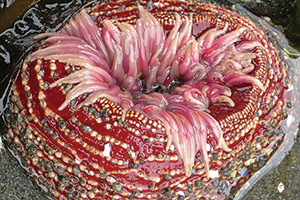Beach Walk FAQs




A beach walk is also called a “beach exploration” — a chance to explore a bit of Salish Sea shoreline and the amazing creatures that inhabit it, guided by a professional naturalist or trained volunteer.
Anyone can participate who’s curious about the watery world around them and able to walk short distances on uneven ground. There’s no minimum age or maximum number of explorers allowed. Beach lovers of all ages enjoy the walks, and you can just show up.
Up to half a mile, but usually much less. Often there’s so much to see we don’t have to go very far.
Each beach walk takes one to two hours.
Unfortunately, most beaches and tideflats aren’t wheelchair accessible. At some events, volunteers may bring sea life from the beach to nearby docks, boat ramps or other accessible structures.
We do. That’s where you can see all sorts of creatures in action — shiner perch and other fishes, jellyfishes, anemones, crabs, stars, mussels, sea slugs and sometimes even pipefish, our local seahorse.
You just have to know what to look for. For example, even if you don’t see any moon snails, you’ll often see evidence of them: egg collars that look like little toilet plungers, holes drilled in clams or a bit of mantle sticking out of the gravel with an enormous snail underneath are clues that a moon snail is below. Pick them up and they’ll ooze through your fingers when you hold them.
Most of those are actually molts — the shells and other body parts that crabs shed periodically as they grow. Those include all of the inside organs that touch water. Imagine if we were to shed every part of us that touches air as we grow, including the linings of our mouths, nasal passages and lungs. It is the same for crabs. The “dead” crab you see is likely alive out there, but much bigger now.
Dead crabs are stinky. Crab molts are clean, and you can take them with you.
Washington Sea Grant and partner Washington State University Kitsap County Extension typically lead three beach walks each winter, and more than 20 in summer, on and around the Kitsap Peninsula. For scheduled walks, check our events calendar.
We go when the tides are low. That means daytime from May through August, but in winter the tides are low at night, so we go then. Evening is a great time for viewing critters — they’re out and about, unconstrained by predators or drying out in the sunlight.
We only cancel beach walks for dangerous, extreme weather such as big storms and ice.
Wear appropriate clothing depending on the weather. Wear hats or sunscreen in summer. It’s always good to wear either knee boots or shoes you don’t mind getting muddy or wet.
Take a Beach Naturalists class. For details go to: http://extension.wsu.edu/kitsap/nrs/water-stewards/beach-naturalists.
To volunteer contact Jeff Adams at WSG, jaws@uw.edu or Amy Smalley at WSU Kitsap Extension, amy.smalley@wsu.edu.
